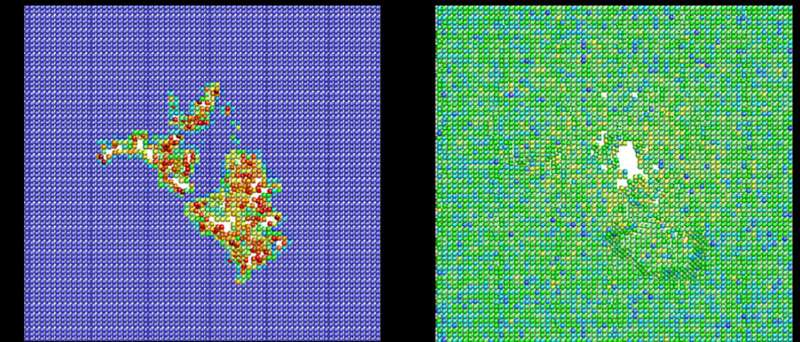Reconsidering damage production and radiation mixing in materials

Understanding the nature of radiation damage in materials is of paramount importance for controlling the safety of nuclear reactors, semiconductor technology, and designing reliable devices in space. For more than 60 years, the standard approach to estimating the radiation damage in materials analytically has been a simple equation known as Kinchin-Pease. However, the displacements-per-atom (DPA) number obtained from this equation does not usually correspond to any physically measurable quantity in common metals. This was established experimentally about 40 years ago, and computer simulations carried out during the last 25 years have firmly established the physical reason for this.
"The explanation is, in brief, that in metals, irradiation produces on picosecond time scales a liquid-like zone, during which the cooling-down phase recombines much of the initially produced damage, leading to a one-third reduction in damage," says Professor Kai Nordlund, who led the team's search for more accurate predictions of usability of materials in nuclear environments. The researchers have published their results in Nature Communications.
"On the other hand, the formation of the transient liquid leads to a massive amount of atoms in the crystal, about a factor of 30 more than the DPA value, being replaced by others after the liquid has cooled down," he says.
Even though these issues are well established, there has until now been no attempt to correct the problems of the standard DPA equations.
In their article, titled "Improving atomic displacement and replacement calculations with physically realistic damage models," the scientists present the outcome of their research. It led to the formulation of two new equations, the athermal recombination-corrected DPA (arc-DPA) and the replacements-per-atom (RPA) functions, which, with a minimal increase in computational complexity, allow for accurate and experimentally testable predictions of damage production and radiation mixing in materials.
The researchers expect that the new equations will be a basis for formulating more reliable and efficient predictions of the usable lifetime of materials in nuclear reactors and other environments with high levels of ionizing radiation. This is especially important for formulating fusion and new kinds of fission nuclear power plants.
More information: Kai Nordlund et al, Improving atomic displacement and replacement calculations with physically realistic damage models, Nature Communications (2018). DOI: 10.1038/s41467-018-03415-5
Journal information: Nature Communications
Provided by University of Helsinki




















